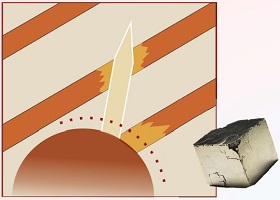Magmatic-Hydrothermal Systems through Time
A special issue of Minerals (ISSN 2075-163X). This special issue belongs to the section "Mineral Deposits".
Deadline for manuscript submissions: closed (18 February 2022) | Viewed by 22762

Special Issue Editors
Interests: economic geology; igneous petrology; metallogeny; greenstone belt; petrogenesis; magmatic-hydrothermal systems; geochemistry
Interests: economic geology; social geology; metallogeny
Special Issue Information
Dear Colleagues,
Magmatic-hydrothermal systems encompass a range of mineralizing styles, including porphyry, greisen, iron-oxides-copper-gold (IOCG), reduced intrusion-related gold systems (RIRGS), and syenite-associated (also referred to as IRGS) and polymetallic veins, and are major sources of Cu, Au, Mo, W, Sn, Li, REE, etc. Mineralizing fluids are exsolved from magmatic systems; may hybridize with meteoric, connate, and sea waters; and their characteristics are thus dependent on the chemistry (including redox state) of the source magma. The chemistry of the magma, in turn, is dependent on the petrogenesis of the magmatic system (source rocks, partial melting conditions, and characteristics of the differentiation process), parameters that can be related to geodynamic settings and secular variations in the crust/mantle composition. Secular variations in the source and the evolution of magmatic systems are documented between Archean and more recent systems, possibly related to the changing geodynamic processes and the characteristics of magmatic-hydrothermal systems. Other parameters, such as fluid/rock interactions or metal partitioning between melt and fluid, likely remained unchanged. A comparison between magmatic-hydrothermal systems of various ages may shed light on many aspects of the large-scale (geodynamic contexts) to local-scale (fluid exsolution and circulation) processes leading to the fertilizing of the Neoarchean upper crust by magmatic systems. The goal of this Special Issue is to put together geochemical, mineralogical, petrological, or other contributions that provide insight into the characteristics of the Archean magmatic-hydrothermal systems and the associated magmatic systems (petrogenesis and physico-chemical parameters). A comparison of the Archean with Proterozoic and modern settings are welcomed. Multi-scale studies that integrate investigations into mineralizing processes from the scale of the deposit to the regional scale are also welcomed.
The Special Issue will include papers presented in the session of the same name at GAC-MAC 2021 in London, Ontario (special session SS-01) but submission is encouraged to all authors wishing to publish new research on magmatic-hydrothermal systems.
Dr. Lucie Mathieu
Prof. Dr. Michel Jébrak
Dr. Nadia Mohammadi
Guest Editors
Manuscript Submission Information
Manuscripts should be submitted online at www.mdpi.com by registering and logging in to this website. Once you are registered, click here to go to the submission form. Manuscripts can be submitted until the deadline. All submissions that pass pre-check are peer-reviewed. Accepted papers will be published continuously in the journal (as soon as accepted) and will be listed together on the special issue website. Research articles, review articles as well as short communications are invited. For planned papers, a title and short abstract (about 250 words) can be sent to the Editorial Office for assessment.
Submitted manuscripts should not have been published previously, nor be under consideration for publication elsewhere (except conference proceedings papers). All manuscripts are thoroughly refereed through a single-blind peer-review process. A guide for authors and other relevant information for submission of manuscripts is available on the Instructions for Authors page. Minerals is an international peer-reviewed open access monthly journal published by MDPI.
Please visit the Instructions for Authors page before submitting a manuscript. The Article Processing Charge (APC) for publication in this open access journal is 2400 CHF (Swiss Francs). Submitted papers should be well formatted and use good English. Authors may use MDPI's English editing service prior to publication or during author revisions.
Keywords
- magmatic-hydrothermal systems
- Archean
- greenstone belts
- secular changes
- magmatic systems
- mineralizing processes
Benefits of Publishing in a Special Issue
- Ease of navigation: Grouping papers by topic helps scholars navigate broad scope journals more efficiently.
- Greater discoverability: Special Issues support the reach and impact of scientific research. Articles in Special Issues are more discoverable and cited more frequently.
- Expansion of research network: Special Issues facilitate connections among authors, fostering scientific collaborations.
- External promotion: Articles in Special Issues are often promoted through the journal's social media, increasing their visibility.
- Reprint: MDPI Books provides the opportunity to republish successful Special Issues in book format, both online and in print.
Further information on MDPI's Special Issue policies can be found here.







